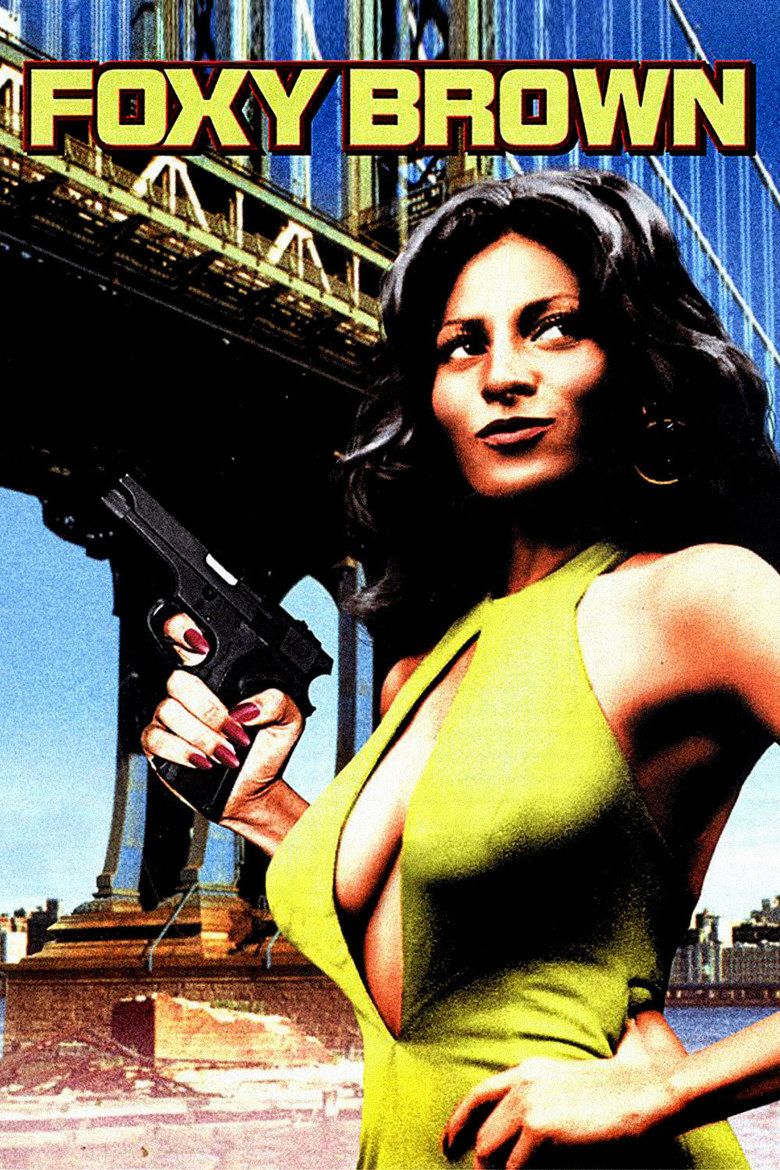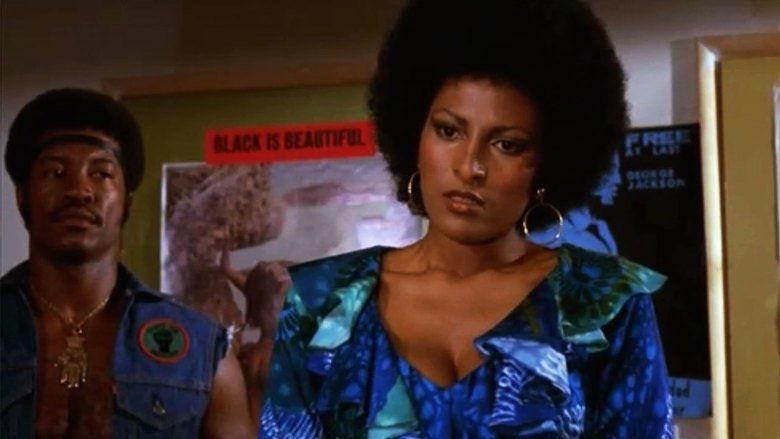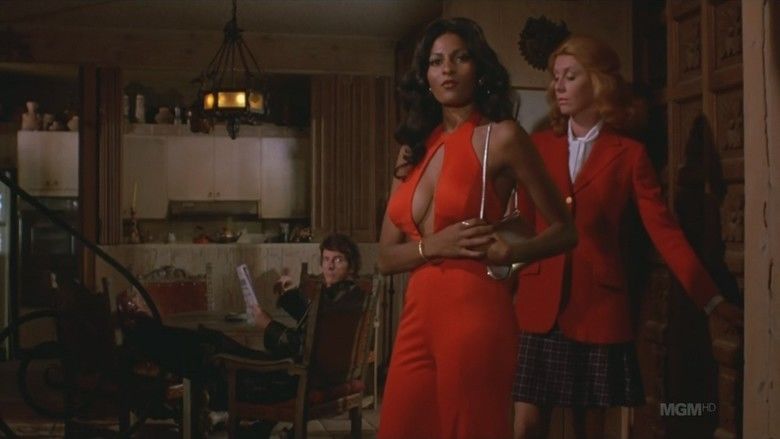Foxy Brown (film)
6.8 /10 1 Votes
60% Rotten Tomatoes Initial DVD release January 9, 2001 Duration Country United States | 6.5/10 IMDb 4/5 Blu-ray Genre Action, Crime, Thriller Language English | |||||||||||||||||||||||||||||||||
 | ||||||||||||||||||||||||||||||||||
Release date April 5, 1974 (1974-04-05) Cast (Foxy Brown), (Link Brown), (Steve Elias), (Dalton Ford), Kathryn Loder (Katherine Wall), (Hays)Similar movies Lucy , The Wolf of Wall Street , Sliver , Irreversible , Se7en , Cleopatra Jones Tagline A chick with drive who don't take no jive! | ||||||||||||||||||||||||||||||||||
Foxy brown official trailer 1 harry holcombe movie 1974 hd
Foxy Brown is a 1974 American blaxploitation film written and directed by Jack Hill. It stars Pam Grier as the title character, described by one character as "a whole lot of woman" who showcases unrelenting sexiness while battling the villains. The film was released by American International Pictures as a double feature with Truck Turner. The film uses Afro-centric references in clothing and hair. Pam Grier starred in six blaxploitation films for American International Pictures.
Contents
- Foxy brown official trailer 1 harry holcombe movie 1974 hd
- Plot
- Stereotypes
- Blaxploitation
- Maternalism
- Womens Power Movement
- Cast
- Production
- Reception
- Soundtrack
- Release on DVD HD
- Influence
- References

While not prosecuted for obscenity, the film was seized and confiscated in the United Kingdom under Section 3 of the Obscene Publications Act 1959 during the video nasty panic.

Plot

Foxy Brown (Pam Grier) seeks revenge when her government agent boyfriend is shot down by members of a drug syndicate at her doorstep. She links her boyfriend's murderers to a "modeling agency" run by Steve Elias (Peter Brown) and Miss Kathryn (Kathryn Loder) that services local judges, congressmen, and police in the area. Foxy decides to pose as a prostitute to infiltrate the company, and helps save a fellow black woman from a life of drugs and sexual exploitation and reunites her with her husband and child. Not long after she infiltrates the company, her relation to her late-boyfriend and Link Brown, her brother who ratted him out, is exposed and she is caught before she can escape. After an exchange of words and heated death threats, Miss Kathryn decides to keep her alive in hopes of her being worth some monetary value in the sex-slave trade. They give her a shot of heroin and then send her to a farm which is actually a drug manufacturing plant, with two of Miss Kathryn's henchmen. After she wakes from her sleep she tries to escape her captors, but is caught by one of the henchmen with a whip and dragged back to the bedroom where he proceeds to tie her to the bed. Then Kathryn's second goon comes and gives Foxy another shot of heroin, the dealer begins to eye Foxy, quoting, "I'm beginning to get that ole feeling" before he begins fondling her breasts & rips off her bra. Tied up and defenseless, the dealer rapes her and leaves. Using her quick thinking, Foxy uses a razor to get free and escape her captors by setting the farm on fire. Ms. Kathryn orders her boyfriend to kill Foxy. He attempts to scare info out of her brother but to no avail. He then kills him and his girlfriend. Foxy asks her Black Panther brothers for help. They take Steve and cut off his genitals. Foxy comes to Ms. Kathryn's house and shows her the jar containing Steve's genitals. She kills two of the guards and shoots Kathryn in the arm. Foxy says that death is too easy for her and wants her to suffer the way that Ms. Kathryn made her suffer.
Stereotypes

According to Yvonne D. Sims in her book Women of Blaxploitation, Foxy Brown was heavily criticized, not only for its “disturbing” portrayal of black womanhood, but also for its controversial stereotypes about violence and drug abuse in black culture. In a time period when African-Americans were making progress politically, socially, and culturally, Foxy Brown's heroine contradicted the image they were creating for themselves in society. Though Foxy is considered a heroine in this film, her role as vengeful black woman willing to pose as a prostitute and exposing herself throughout the film goes against some of the characteristics one would expect in a heroine. It also addresses the stereotype of the objectification of black women. Nelson George states that Pam Grier has been embraced by many feminists for her roles that not only display her beauty, but also her fearlessness and ability to exact retribution on men who challenge her.
Blaxploitation
Blaxploitation is a genre of exploitation film that usually targets the black audience in urban communities. Blaxploitation were very popular at the time this film was made after parts of the film industry saw untapped box-office potential in the black audience. The reputation of Blaxploitation film has gone from being categorized as low-budget black films to American Classics that people read and teach discourse on. Although Blaxploitation is criticized for being another avenue of exploiting African-American culture, at the time, it was one of the few ways for African-Americans to get into the film industry. Grier talks about this in an interview with Essence in 1979:
"Why would people think I would ever demean the Black woman? I was tried and convicted without being asked to testify in my defense. Sure, a lot of those films were junk. But they were what was being offered. They provided work for me and jobs for hundreds of Blacks. We all needed to work. We all needed to eat."
Maternalism
In Foxy Brown and Coffy (1973), there is a distinct characteristic that the women share; they are nurturers. In each film, the plot surrounds justice for a loved one that was a victim of drug abuse, violence, and gang activity. Foxy wants revenge for her late-boyfriend, Michael, and she also wants to shut down the drug and prostitute operation so they can no longer harm her community. The director Jack Hill made an obvious reference to Angela Davis, the American activist, when she was talking to Black Caesar and she demands they get justice for "all of the people." In Coffy, Grier was seeking revenge against the drug underworld for her younger sister getting hooked on drugs and now has to live in a rehabilitation home. In both films, the women risk their lives carrying out vigilant missions in order to make the streets a better place, but also, and more importantly, to avenge their family.
Women's Power Movement
This movie spoke directly to the women's power movement and struggle in the 1970s. Despite criticism, Foxy was the poster child for a new type of heroine that was subsequently appropriated by the blaxploitation genre. She redefined African-American beauty, sexuality, and womanhood which led to the diversification of African-American actresses onscreen. Grier said:
"The 1970s was a time of freedom and women saying that they needed empowerment. There was more empowerment and self-discovery than any other decade I remember. All across the country, a lot of women were Foxy Brown and Coffy. They were independent, fighting to save their families not accepting rape or being victimized... This was going on all across the country. I just happened to do it on film. I don't think it took any great genius or great imagination. I just exemplified it, reflecting it to society."
Additionally, Foxy Brown and Coffy show that women can stand up for themselves and what they believe in. The image of Foxy in an evening gown, well-equipped with a gun is a visual representation of that idea that you don't have to be masculine to have power. "Female power," according to Grier, is "very different than male power, and a woman should maintain it always.'"'
Cast
Production
According to director Jack Hill, due to tension between himself and AIP (American International Pictures) they did not invite Hill to do the sequel for Coffy until last-minute. Tensions arose due to a screening AIP invited Hill to, of a movie they had been working on and were eager to show. Hill walked out, unimpressed, and AIP made a vow to never hire him again. However, with Coffy being such a huge success, Sam Arkoff, who had the final say, decided to invite him back into the fold.
Foxy Brown was originally intended to be a sequel to his Coffy (1973), also starring Pam Grier, and in fact the working title of the film was "Burn, Coffy, Burn!". However, AIP decided at the last minute it did not want to do a sequel, even though Coffy was a huge hit. Therefore, it is never said exactly what kind of job Foxy Brown has -- "Coffy" was a nurse and since this was no longer to be a sequel, they could not give Foxy Brown that job and did not have time to rewrite the script to establish just what kind of job she had.
On the audio commentary on the film's DVD release, Hill also mentioned that he was initially against the outfits that the wardrobe department chose for Foxy Brown. Since Pam Grier had become a star in her prior film Coffy, there was an impetus to present the actress as even more stylish than she had appeared in the previous film. The 14 costumes were designed by a California couturier named Ruthie West, who was also the stylist for the Jackson 5, Thelma Houston, Bobbie Gentry, Cutis The Brothers, and Sister Love, among others.
But Hill, by his own account, initially felt that the outfits were too trendy and specific to the time period, and within a few years would cause the film to look dated and obsolete. In the years since the film's release, however, Hill has reversed his opinion on Foxy's clothes, particularly in the wake of not only Foxy Brown's ascent into pop culture icon, but also the '70s nostalgia movement that started in the mid-1990s.
Hill also mentioned that the character of Foxy Brown became something of a female empowerment symbol that seemed to transcend the time period of the film. As such, Hill believes, Foxy's 1970s clothes and hairstyles merely add to the charm of the character.
Reception
Foxy Brown was a financial success. Produced on a budget of $500,000, it grossed $2,460,000.
The film received mixed reviews from critics. The movie received a negative reception from Variety magazine. In the Variety issue on Wednesday, April 17, 1974, they characterized the film as being "something of a mess". The gory samples of violence and explicit sexual scenes, according to Variety, made it harder to stomach, and is beneath even the "gutter-high standards of the genre." The article refers to the following Grier has gained in the recent plight of her career, and believe she can do more than just nitty-gritty blaxploitation.
In more positive reviews, she is described as one of Hollywood's newest stars. She gained top billing in "Foxy Brown" and that she had the star caliber to "carry a film and to have the title role." The film scores a 60% "Fresh" rating on Rotten Tomatoes.
The film is recognized by American Film Institute in these lists:
Soundtrack
The film's songs were written and performed by Willie Hutch, and a soundtrack album was released on Motown Records in 1975.
Release on DVD & HD
Influence
Foxy Brown is one of the most influential blaxploitation films; Pam Grier's character is often considered to be the female archetype of the genre. The film has directly influenced or been mentioned in many other films, including, but not limited to:
It is often noted by film historians as one of the first blaxploitation films to provide a portrayal of a strong and independent woman; until Pam Grier, women often existed exclusively to support their men for a small part of the film.
Additionally, Foxy Brown and the preceding film Coffy are unique for their establishment of pushers and pimps as villains. Before these films, the blaxploitation genre often espoused empathy for the social positions of such individuals.
Pam Grier titled her memoir Foxy: My Life in Three Acts (2010), clearly influenced by this film.
References
Foxy Brown (film) WikipediaFoxy Brown (1974 film) IMDbFoxy Brown (1974 film) Rotten TomatoesFoxy Brown (1974 film) Blu-ray.comFoxy Brown (film) themoviedb.org
